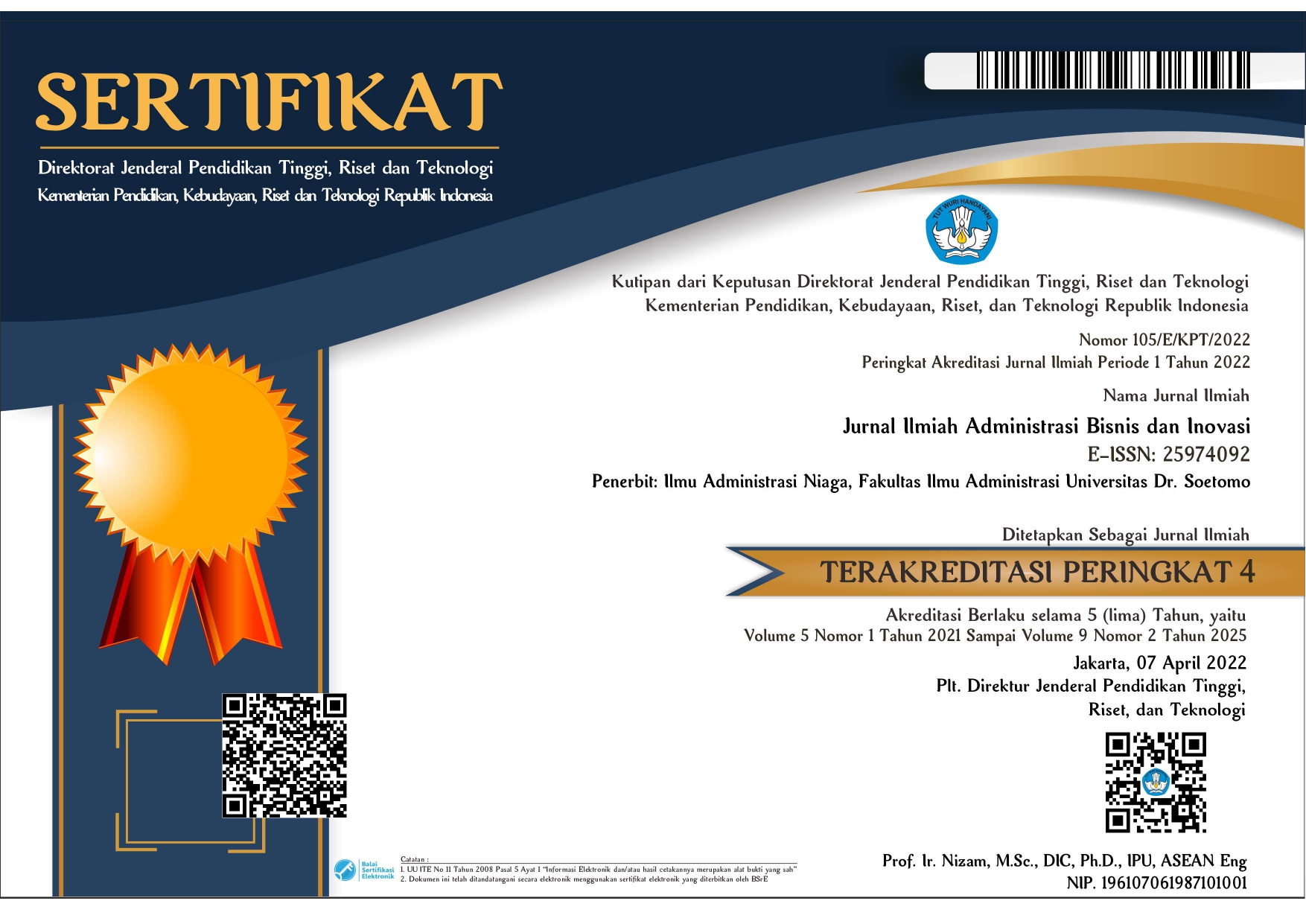IDENTIFIKASI BUSINESS PERFORMANCE UKM DENGAN SKEMA KLASIFIKASI INTELLECTUAL CAPITAL
 Abstract views: 468
,
Abstract views: 468
,
 PDF downloads: 367
PDF downloads: 367
Abstract
When a company tries to find a business performance formula that can become a new solution in order to maintain its survival, then it depends on how its ability to manage its assets. So this study aims to examine the relationship of three main components of Intellectual Capital and Business Performance from Bontis at al: Human Capital, Structural Capital, Relational Capital. Hypothesis testing is conducted on the positive relationship between Human Capital and Business Performance, the positive relationship between Structural Capital and Business Performance, the positive relationship between Relational Capital and Business Performance, and the positive relationship between Intellectual Capital (IC) and Business Performance. Data collection techniques using a questionnaire developed from IC sub-factors based on the Intellectal Capital Classification Scheme from Moon and Kym, given directly to respondents or managers / business owners with a sample of 30 companies, then the data collected was analyzed using the IBM 20.0 SPSS program. Positive inter-variable influences have been found accompanied by rejected hopothesis.
References
Anggadwita, G., & Mustafid, Q. Y. (2014). Identification of Factors Influencing the Performance of Small Medium Enterprises (SMEs). Procedia - Social and Behavioral Sciences, 115, 415–423. https://doi.org/10.1016/j.sbspro.2014.02.448
Arraniri, I. (2019). STRATEGI BISNIS USAHA PASTEL MINI DESA TENJOLAYAR, 02(20), 48–59.
Bontis, N., Ph, D., & West, M. S. (n.d.). A SSESSING K NOWLEDGE A SSETS : A Review of the Models Used to Measure Intellectual Capital.
Bontis, N., William Chua Chong, K., & Richardson, S. (2000). Intellectual capital and business performance in Malaysian industries. Journal of Intellectual Capital, 1(1), 85–100. https://doi.org/10.1108/14691930010324188
Dwi, M., Astri, P., & Susanto, A. (2008). Analisis Pengaruh Human Capital Terhadap Kinerja Perusahaan (Studi Empiris pada Kantor Akuntan Publik di Indonesia). Jurnal Akuntansi Dan Keuangan, 10(1), 11–21. https://doi.org/10.9744/jak.10.1.PP.11-21
Edvardsson, I. R., & Durst, S. (2013). The Benefits of Knowledge Management in Small and Medium-sized Enterprises. Procedia - Social and Behavioral Sciences, 81, 351–354. https://doi.org/10.1016/j.sbspro.2013.06.441
Ekonomika, F., Bisnis, D. A. N., & Diponegoro, U. (2013). Pengaruh Modal Intelektual Terhadap Kinerja Bisnis Bank Umum Syariah (Bus) Di Indonesia. Pengaruh Modal Intelektual Terhadap Kinerja Bisnis Bank Umum Syariah (Bus) Di Indonesia, 408–417.
Gay, L.R. dan Diehl, P. L. (1992). Research Methods for Business and. Management. New York: MacMillan Publishing Company.
Harry, M. (2000). Organisational learning in small learning organisations: an empirical overview. Education + Training, 42(4/5), 202–211. https://doi.org/10.1108/00400910010373642
Hermawan, S. (2017). Makna Intellectual Capital Perspektif the Role Theory Dan the Resource Based Theory. EKUITAS (Jurnal Ekonomi Dan Keuangan), 17(2), 256. https://doi.org/10.24034/j25485024.y2013.v17.i2.2252
Huang, C. F., & Hsueh, S. L. (2007). A study on the relationship between intellectual capital and business performance in the engineering consulting industry: A path analysis. Journal of Civil Engineering and Management, 13(4), 265–271. https://doi.org/10.1080/13923730.2007.9636446
Indriastuti, M. dan D. A. A. (2012). Peningkatan Kinerja UKM dengan Pengelolaan Intellectual Capital dan Inovasi (pp. 649–661). Proceedings of Conference in Business, Accounting and Management (CBAM).
Iswati, S., Widodo M., A., Hendarjanto, ., Anshori, A., & Swasana, D. (2019). Intellectual Capital Model in SME’s Tour and Travel in Surabaya, (June), 875–878. https://doi.org/10.5220/0007553208750878
Kompyurini, N. (2010). Pengaruh Intellectual Capital Terhadap Business Performance Dengan Pendekatan Balanced Scorecard Pada Perusahaan Manufaktur Berskala Besar Di Surabaya. Jurnal Investasi Juni, 6(1), 14–30.
Kuningan, B. P. S. (2018). Kabupaten Kuningan dalam Angka 2018. (S. I. P. dan D. Statistik, Ed.). Kuningan Jawa Barat: Badan Pusat Statistik Kabupaten Kuningan. https://doi.org/1102001.3208
Lela Nurlaela Wati. (2018). Metodologi Penelitian Terapan, Aplikasi SPSS, EVIEWS, Smart PLS dan AMOS. (Momon, Ed.) (2nd ed.). Jakarta: CV. Mujahid Press. Retrieved from www.mujahidpress.com
Marzo, G., & Scarpino, E. (2016). Exploring intellectual capital management in SMEs: an in-depth Italian case study. Journal of Intellectual Capital, 17(1), 27–51. https://doi.org/10.1108/JIC-09-2015-0075
Moon, Y. J., & Kym, H. G. (2009). A Model for the Value of Intellectual Capital. Canadian Journal of Administrative Sciences / Revue Canadienne Des Sciences de l’Administration, 23(3), 253–269. https://doi.org/10.1111/j.1936-4490.2006.tb00630.x
Mumpuni, K. H. (2013). ( Studi Persepsi Karyawan PT BPR Setia Karib Abadi Semarang ), 2, 1–14.
Patricia, O. de P. (2002). Evidence of intellectual capital measurementfrom Asia, Europe andthe Middle East. Journal of Intellectual Capital, 3(3), 287–302. https://doi.org/10.1108/14691930210435624
Pertiwi, D., Katili, P. B., & Anggraeni, S. K. (2013). Analisa Hubungan Intellectual Capital Terhadap Business Performance pada Industri Manufaktur. Jurnal Teknik Industri, 1(3), 265–271.
Sigit Hermawan, S. H. (2013). Studi Intepretif Identifikasi dan Interaksi Intellectual Capital terhadap Kinerja Perusahaan. Jurnal Reviu Akuntansi Dan Keuangan, 3(1), 335–347.
Telaah, J., & Akuntansi, R. (2008). Pengaruh Intellectual Capital Dan Corporate Social Responsibility Terhadap Kinerja Perusahaan (Studi Empiris Pada Perusahaan Manufaktur Di Bursa Efek Indonesia). Jurnal Telaah Dan Riset Akuntansi, 1(2), 192–213.
Authors who publish with Inform: JIABI: Jurnal Ilmiah Administrasi Bisnis dan Inovasi agree to the following terms:
Authors retain copyright and grant the journal right of first publication with the work simultaneously licensed under a Creative Commons Attribution License (CC BY-SA 4.0) that allows others to share the work with an acknowledgment of the work's authorship and initial publication in this journal.
Authors are able to enter into separate, additional contractual arrangements for the non-exclusive distribution of the journal's published version of the work (e.g., post it to an institutional repository or publish it in a book), with an acknowledgment of its initial publication in this journal.
Authors are permitted and encouraged to post their work online (e.g., in institutional repositories or on their website) prior to and during the submission process, as it can lead to productive exchanges, as well as earlier and greater citation of published work.









